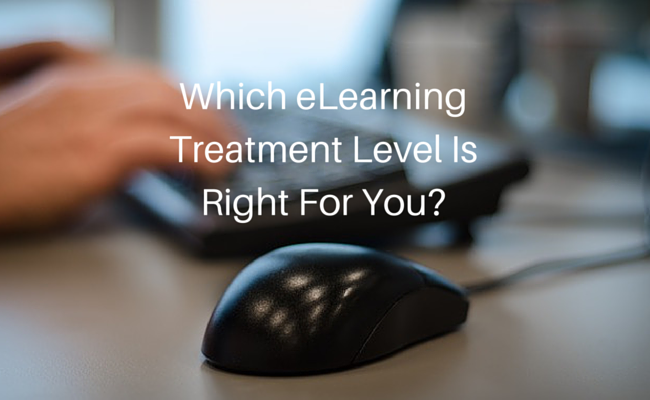
Different types of eLearning require different levels of interactivity. Some are just needed to share generic information, while some need to really engage learners with material that can be transformed into hands-on training.
Before you begin designing and developing a new eLearning course, be sure to identify which eLearning treatment level your course needs to be effective. This decision will influence everything from your budget and time frame to technical needs.
Let’s start with the highest level of user engagement and work our way down the list.
Simulation & Gamification
In this level, learners get the highest level of interaction with the course material through simulation and games that hold on tight to the users’ attention. These might come in the form of:
Multimedia (videos, audio portions, and interactive graphics)
Serious Games & gamified activities
Digital characters who must complete tasks
3D simulations that teach how to use software or hardware
Moderate Engagement
These types of eLearning courses are one step down from the previous level, but are still customized with interactive elements that go beyond presentation of facts and information. There’s a nice balance here between engagement and teaching. These types of courses include:
Animations that allow users to click and explore
Branched scenarios that employ decision-making processes
Videos
Custom audio that reinforces company branding
Data entry
Low Interaction
For learners who are being presented general information (but still need their attention held throughout the course), low interaction courses present a mild level of interaction that goes beyond reading, watching, and clicking through the content. These types of courses are best for simple data and refresher courses. Interaction comes from:
Graphics with clickable features
External resources that can be explored
Simple exercises and quizzes (like drag and drop or matching tests)
Video and audio
Linear (No Interaction)
These eLearning courses have the lowest level of interaction and are merely used for basic training and information presentation. We know these as “page turners” and they work by presenting content in a fixed order format. Commonly found features are:
Simple quiz questions
Basic graphics
Rollover features
Pick your eLearning Treatment Level
While it’s easy to assume “bigger is always better” that’s not the case in all instances. Not only are there significant budgetary implications between the different levels, but the level needs to be matched with the content, the audience, and the environment.
For a client that insists on a “check the box” course, that might not be where you want to invest lots of money. Or in environments where people just need updated information and don’t have the time (or tolerance) to sit through lengthy interactive content, you might be better served with simple solutions.
Sometimes, this might even mean the right delivery is more basic than eLearning and would be better delivered as a document or some other traditional format. But in cases where there is real learning or behavior change needed, those can be cases where raising the engagement level will help bring home the results you need.
Depending on the level of engagement that is right for your course and your environment, your learners will accomplish different learning objectives. Be sure to check with your client to be sure the eLearning treatment level you’ve agreed upon does everything you need it to. If not, discuss how you can come to a compromise on budget and time frame to make the necessary changes.
